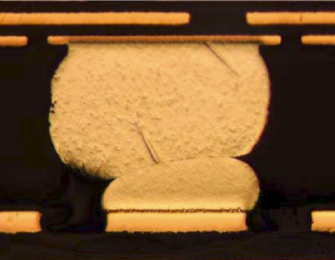Head in Pillow Issues
Issue Description: Head in pillow (HiP) occurs when a solder sphere does not coalesce with the solder paste deposit underneath it. The defect looks like a head on a pillow.
 1) Minimizing or remove the oxide from the solder sphere will correct this issue. Oxides act as a barrier between the solder sphere and solder paste.
1) Minimizing or remove the oxide from the solder sphere will correct this issue. Oxides act as a barrier between the solder sphere and solder paste.
Higher concentrations of activators and the use of different activators in the solder paste are a common way to deal with this issue. Higher activity levels in solder paste allow the solder paste flux to completely clean and remove oxides from the solder sphere. WS889A8 is a higher activity version of our WS889 solder paste, NL932X and NL930PTX are higher activity versions of NL932 and NL930PT solder pastes.
Use of nitrogen during reflow will minimize the amount of oxide that can form on the solder sphere during reflow.
2) Modification of the stencil design to increase the volume of solder paste results in more flux to deal with the oxide on the solder sphere.
Increasing aperture size is a fairly simple way to increase solder paste volume and the amount of flux present. One must be aware of potential bridging issues with fine pitch components.
3) Modification of the reflow profile can help with coalescence of the solder sphere and solder paste.
Reduction of soak time will reduce the amount of oxide that can form on the solder sphere before the solder becomes liquid.
Increasing time above liquidus will provide more time for complete coalescence of the solder.
4) Replace the solder paste with tacky (gel) flux to ensure that the activity level is high enough to provide good soldering to the board and component.
Tacky or gel flux is 100% flux, while solder pastes typically contain 10% flux. Therefore tacky flux has 10 times more activity than solder paste.
The size of the solder spheres used may have to be increased to ensure that the solder joint volume is adequate.

